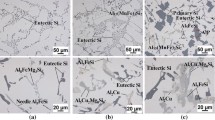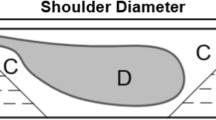Abstract
Friction stir welding (FSW) is a technique that can be used for materials joining and local microstructural refinement. Owing to the solid-state character of the process, FSW has significant advantages over traditional fusion welding, including reduced part distortion and overheating. In this study, a novel heat transfer model was developed to predict weld temperature distributions and quantify peak temperatures under various combinations of processing parameters for different wrought and cast Al alloys. Specifically, an analytical analysis was first developed to characterize and predict heat generation rate within the weld nugget, and then a two-dimensional (2D) numerical simulation was performed to evaluate the temperature distribution in the weld cross-section and top-view planes. A further three-dimensional (3D) simulation was developed based on the heat generation analysis. The model was validated by measuring actual temperatures near the weld nugget using thermocouples, and good agreement was obtained for all studied materials and conditions.















Similar content being viewed by others
Abbreviations
- \( \dot{H} \) :
-
Heat generation rate per unit area (or volume)
- \( H_{\text{D}} \) :
-
Combined heat dissipation rate
- \( V_{0} \) :
-
Unit volume
- \( \rho \) :
-
Density of the alloy
- \( C_{\text{p}} \) :
-
Heat capacity of the alloy
- \( k \) :
-
Thermal conductivity of the alloy
- \( k^{\prime } \) :
-
Thermal conductivity of fixture material
- \( \dot{h} \) :
-
Heat flux
- \( h \) :
-
Surface heat transfer coefficient
- \( \omega \) :
-
Tool rotation rate
- \( v \) :
-
Tool traverse rate
- t :
-
Time
- X i :
-
Distance of tool travel
- \( X_{\text{t}} \) :
-
Tool effective distance
- n :
-
Geometry factor
- \( T_{\text{nug}} \) :
-
Nugget temperature
- \( T_{\text{bound}} \) :
-
Boundary temperature
- \( T_{\text{amb}} \) :
-
Ambient temperature
- \( W_{0} \) :
-
Half width of workpiece
- \( L_{0} \) :
-
Length of workpiece
- \( L_{\text{z}} \) :
-
Thickness of workpiece
- \( b_{i} \) :
-
Workpiece dimensions at “i” location
- \( A_{j} \) :
-
Surface area at specific boundary “j”
- C :
-
Cooling coefficient
- Q 1 :
-
Rotation heating coefficient
- Q 2 :
-
Traverse heating coefficient
References
W.M. Thomas, E.D. Nicholas, J.C. Needham, M.G. Murch, P. Templesmith and C.J. Dawes: GB Patent Application No. 9125978.8, 1991.
C.J. Dawes and W.M. Thomas: TWI Bull. 6, 1995, pp. 124–27.
R.S. Mishra and Z.Y. Ma: Mat. Sci. Eng. R, 2005, 50: pp. 1–78.
[4] P.S. De, N. Kumar, J.Q. Su and R.S. Mishra: ASM Hand, vol. 6A, 2011, pp.186-200.
P. Dong, F. Lu and J.K. Hong: Sci. Technol. Weld. Joi, 2001, 6(5): pp. 281–87.
C.G. Rhodes, M.W. Mahoney, W.H. Bingel, R.A. Spurling and C.C. Bampton, Scripta Mater., 1997, 36: pp. 69–75.
L.E. Murr, G. Liu and J.C. McClure: J. Mater. Sci., 1998, 33: pp.1243–51.
C.M. Chen and R. Kovacevic: Int. J. Mach. Tool. Manuf., 2003, 43: pp. 1319–26.
S. Cartigueyena, O.P. Sukeshb and K. Mahadevanc: Proc. Eng., 2014, 97: pp. 1069–78.
D. Deng and S. Kiyoshima: Comp. Mater. Sci., 2012, 62: pp. 23–24.
M. Song and R. Kovacevic: Int. J. Mach. Tool. Manuf., 2003, 43: pp. 605–15
M. Song and R. Kovacevic: Proc. Inst. Mech. Eng., B J. Eng. Manuf., 2002, 216(12): pp. 73–85.
A. Larsen: Int. J. Comput Aided Eng. Softw., 2012, 29(1): pp. 65–82.
H.B. Schmidt and J.H. Hattel: Scripta Mater., 2008, vol. 58: pp. 332–37.
M.Z.H. Khandkar, J.A. Khan and A.P. Reynolds: 6th international trends in welding research conference proceedings, Pine Mountain, 2002
C. Ma and S. Chang: Int. J. Heat Mass Transfer, 2004, 47: pp. 1643–55.
G. Buffa, A. Ducato and L. Fratini: Finite Elem. Anal. Des., 2011, 47(4): pp. 470–76.
Y.J. Chao and X. Qi, W. Tang: J. Manuf. Sci. E., 2003, 125: pp. 138–45.
J.G. Kaufman: Aluminum Alloy Database, Knovel, Norwich, 2004.
J. Arbegast William: Scripta Mater., 2008, 58: pp. 372–76.
S. Tutunchilar, M. Haghpanahi, M.K. Besharati Givi, P. Asadi and P. Bahemmat: Mater. Des, 2012, 40: pp. 415–26.
Acknowledgments
This study was accomplished with both technical and financial support from the Integrative Materials Design Center (iMdc) at Worcester Polytechnic Institute (WPI). Thanks are given to Torbjorn Bergstrom and the machine shop staff at WPI for their help with the friction stir welding experiments. Special thanks go to Lin Zhang and Chrysler Group LLC for preparing the cast aluminum alloys used in these studies.
Author information
Authors and Affiliations
Corresponding author
Additional information
Manuscript submitted September 30, 2015.
Rights and permissions
About this article
Cite this article
Pan, Y., Lados, D.A. Friction Stir Welding in Wrought and Cast Aluminum Alloys: Heat Transfer Modeling and Thermal History Analysis. Metall Mater Trans A 48, 722–734 (2017). https://doi.org/10.1007/s11661-016-3865-0
Received:
Published:
Issue Date:
DOI: https://doi.org/10.1007/s11661-016-3865-0




